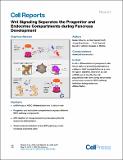| dc.contributor.author | Sharon, Nadav | |
| dc.contributor.author | Vanderhooft, Jordan | |
| dc.contributor.author | Straubhaar, Juerg | |
| dc.contributor.author | Mueller, Jonas Weylin | |
| dc.contributor.author | Chawla, Raghav | |
| dc.contributor.author | Zhou, Quan | |
| dc.contributor.author | Engquist, Elise N. | |
| dc.contributor.author | Trapnell, Cole | |
| dc.contributor.author | Gifford, David K | |
| dc.contributor.author | Melton, Douglas A. | |
| dc.date.accessioned | 2020-12-23T20:50:09Z | |
| dc.date.available | 2020-12-23T20:50:09Z | |
| dc.date.issued | 2019-05 | |
| dc.date.submitted | 2019-01 | |
| dc.identifier.issn | 2211-1247 | |
| dc.identifier.uri | https://hdl.handle.net/1721.1/128920 | |
| dc.description.abstract | In vitro differentiation of pluripotent cells into β cells is a promising alternative to cadaveric-islet transplantation as a cure for type 1 diabetes (T1D). During the directed differentiation of human embryonic stem cells (hESCS) by exogenous factors, numerous genes that affect the differentiation process are turned on and off autonomously. Manipulating these reactions could increase the efficiency of differentiation and provide a more complete control over the final composition of cell populations. To uncover in vitro autonomous responses, we performed single-cell RNA sequencing on hESCs as they differentiate in spherical clusters. We observed that endocrine cells and their progenitors exist beside one another in separate compartments that activate distinct genetic pathways. WNT pathway inhibition in the endocrine domain of the differentiating clusters reveals a necessary role for the WNT inhibitor APC during islet formation in vivo. Accordingly, WNT inhibition in vitro causes an increase in the proportion of differentiated endocrine cells. | en_US |
| dc.language.iso | en | |
| dc.publisher | Elsevier BV | en_US |
| dc.relation.isversionof | http://dx.doi.org/10.1016/j.celrep.2019.04.083 | en_US |
| dc.rights | Creative Commons Attribution-NonCommercial-NoDerivs License | en_US |
| dc.rights.uri | http://creativecommons.org/licenses/by-nc-nd/4.0/ | en_US |
| dc.source | Elsevier | en_US |
| dc.title | Wnt Signaling Separates the Progenitor and Endocrine Compartments during Pancreas Development | en_US |
| dc.type | Article | en_US |
| dc.identifier.citation | Sharon, Nadav et al. "Wnt Signaling Separates the Progenitor and Endocrine Compartments during Pancreas Development." Cell Reports 27, 8 (May 2019): P2281-2291.e5 © 2019 The Authors | en_US |
| dc.contributor.department | Massachusetts Institute of Technology. Computer Science and Artificial Intelligence Laboratory | en_US |
| dc.contributor.department | Massachusetts Institute of Technology. Department of Electrical Engineering and Computer Science | en_US |
| dc.relation.journal | Cell Reports | en_US |
| dc.eprint.version | Final published version | en_US |
| dc.type.uri | http://purl.org/eprint/type/JournalArticle | en_US |
| eprint.status | http://purl.org/eprint/status/PeerReviewed | en_US |
| dc.date.updated | 2020-12-15T17:12:52Z | |
| dspace.orderedauthors | Sharon, N; Vanderhooft, J; Straubhaar, J; Mueller, J; Chawla, R; Zhou, Q; Engquist, EN; Trapnell, C; Gifford, DK; Melton, DA | en_US |
| dspace.date.submission | 2020-12-15T17:12:58Z | |
| mit.journal.volume | 27 | en_US |
| mit.journal.issue | 8 | en_US |
| mit.license | PUBLISHER_CC | |
| mit.metadata.status | Complete | |
